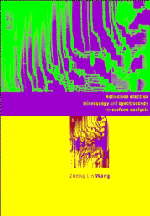Book contents
- Frontmatter
- Contents
- Preface
- Symbols and definitions
- 0 Introduction
- 1 Kinematical electron diffraction
- Part A Diffraction of reflected electrons
- Part B Imaging of reflected electrons
- 5 Imaging surfaces in TEM
- 6 Contrast mechanisms of reflected electron imaging
- 7 Applications of UHV REM
- 8 Applications of non-UHV REM
- Part C Inelastic scattering and spectrometry of reflected electrons
- Appendix A Physical constants, electron wavelengths and wave numbers
- Appendix B The crystal inner potential and electron scattering factor
- Appendix C.1 Crystallographic structure systems
- Appendix C.2 A FORTRAN program for calculating crystallographic data
- Appendix D Electron diffraction patterns of several types of crystal structures
- Appendix E.1 A FORTRAN program for single-loss spectra of a thin crystal slab in TEM
- Appendix E.2 A FORTRAN program for single-loss REELS spectra in RHEED
- Appendix E.3 A FORTRAN program for single-loss spectra of parallel-to-surface incident beams
- Appendix E.4 A FORTRAN program for single-loss spectra of interface excitation in TEM
- Appendix F A bibliography of REM, SREM and REELS
- References
- Materials index
- Subject index
5 - Imaging surfaces in TEM
Published online by Cambridge University Press: 18 January 2010
- Frontmatter
- Contents
- Preface
- Symbols and definitions
- 0 Introduction
- 1 Kinematical electron diffraction
- Part A Diffraction of reflected electrons
- Part B Imaging of reflected electrons
- 5 Imaging surfaces in TEM
- 6 Contrast mechanisms of reflected electron imaging
- 7 Applications of UHV REM
- 8 Applications of non-UHV REM
- Part C Inelastic scattering and spectrometry of reflected electrons
- Appendix A Physical constants, electron wavelengths and wave numbers
- Appendix B The crystal inner potential and electron scattering factor
- Appendix C.1 Crystallographic structure systems
- Appendix C.2 A FORTRAN program for calculating crystallographic data
- Appendix D Electron diffraction patterns of several types of crystal structures
- Appendix E.1 A FORTRAN program for single-loss spectra of a thin crystal slab in TEM
- Appendix E.2 A FORTRAN program for single-loss REELS spectra in RHEED
- Appendix E.3 A FORTRAN program for single-loss spectra of parallel-to-surface incident beams
- Appendix E.4 A FORTRAN program for single-loss spectra of interface excitation in TEM
- Appendix F A bibliography of REM, SREM and REELS
- References
- Materials index
- Subject index
Summary
Techniques for studying surfaces in TEM
There are two basic modes of TEM operation, namely the bright-field mode, wherein the (000) transmitted beam contributes to the image, and the dark-field imaging mode, in which the (000) beam is excluded. The size of objective aperture in bright-field mode directly determines the information to be emphasized in the final image. When the size is chosen so as to exclude the diffracted beams, one has the configuration that is normally used for low-resolution defect studies, the so-called diffraction contrast. In this case, a crystalline specimen is oriented to excite a particular diffracted beam, or systematic row of reflections. This imaging mode is sensitive to the differences in specimen thickness, distortion of crystal lattices due to defects, strain and bends. High-resolution imaging is usually performed in bright-field mode by including a few Bragg-diffracted beams within the objective aperture. The lattice images are the result of interference between Bragg reflected beams, the so-called phase contrast. In this section, we outline a few techniques that have been extensively developed for studying surfaces in high-resolution TEM (HRTEM) (Cowley, 1986; Smith, 1987).
Imaging using surface-layer reflections
The dark-field imaging technique is favorable for imaging surfaces when the surface layers have different periodicity from that of the bulk of the crystal (Figure 5.1 (a)). Then ‘superlattice’ satellite reflections appear in the diffraction pattern and dark-field imaging with these spots can give high-contrast images of surface structure.
There are two basic mechanisms for generating the superlattice reflections. A sharp termination of the crystal bulk at the surface may form a stacking sequence that is not a complete unit cell.
- Type
- Chapter
- Information
- Publisher: Cambridge University PressPrint publication year: 1996

